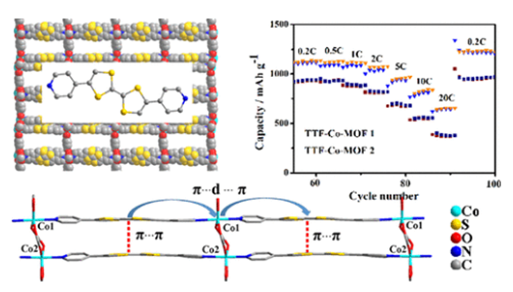Tetrathiafulvalene−Cobalt Metal−Organic Frameworks for LithiumIon Batteries with Superb Rate Capability
Yi-Gang Weng, Zhou-Hong Ren, Zhi-Ruo Zhang, Jie Shao, Qin-Yu Zhu*(朱琴玉), and Jie Dai*(戴洁)
College of Chemistry, Chemical Engineering and Materials Science, Soochow University, Suzhou 215123, P. R. China
Inorg. Chem. 2021, 60, 17074--17082
Although pristine metal–organic framework (MOF) anodes for lithium-ion batteries (LIBs) show moderate activities and relatively stable cycling, the poor rate capability of the MOF anodes limited their applications in the development of a new generation of energy storage. Herein, the electric active CoII ion is selected to coordinate with redox-active S-rich tetrathiafulvalene (TTF) derivatives to create two TTF-Co-MOFs, formulated as [Co2(py-TTF-py)2(BDC)2]·2DMF·H2O (TTF-Co-MOF 1) and [Co2(py-TTF-py)2(BPDC)2]·3DMF·3H2O (TTF-Co-MOF 2), where py-TTF-py = 2,6-bis(4′-pyridyl)tetrathiafulvalene, H2BDC = terephthalic acid, H2BPDC = biphenyl-4,4′-dicarboxylic acid, and DMF = N,N-dimethylformamide. Crystallographic characterization indicated that the two MOFs possess similar 2-fold-interpenetrating 3D frameworks but with two different pore sizes. The pore-size-dependent performances of the TTF-Co-MOFs were explored to optimize the MOFs as the anode materials for LIBs. TTF-Co-MOF 1 presents a high reversible specific capacity of 1186.6 mAh g–1 at 200 mA g–1 after 287 cycles. The rate capability is greatly enhanced by the introduction of CoII into TTF-based MOFs with specific capacities of 1028.6 mAh g–1 at 5 A g–1 and 966.5 mAh g–1 at 10 A g–1. On the basis of the series analysis of theoretical calculations, electrochemical impedance spectroscopy, and crystal structures, it is found that the CoII metal centers play a bridging role in charge transport within the MOF framework, which is beneficial for the transportation of Li ions. The competitive performances of TTF-Co-MOF 1 are attributed to the synergistic effect of the CoII metal centers and S-rich TTF ligand as well as suitable porosity. The study shed some light for the fabrication of advanced energy storage devices through the rational design of MOF-based anode materials.

链接://pubs.acs.org/doi/10.1021/acs.inorgchem.1c02304